Scenes and nodes¶
Introduction¶

Imagine for a second that you are not a game developer anymore. Instead, you’re a chef! Change your hipster outfit for a toque and a double breasted jacket. Now, instead of making games, you create new and delicious recipes for your guests.
So, how does a chef create a recipe? Recipes are divided into two sections: the first is the ingredients and the second is the instructions to prepare it. This way, anyone can follow the recipe and savor your magnificent creation.
Making games in Godot feels pretty much the same way. Using the engine feels like being in a kitchen. In this kitchen, nodes are like a refrigerator full of fresh ingredients with which to cook.
There are many types of nodes. Some show images, others play sound, other nodes display 3D models, etc. There are dozens of them.
Nodes¶
But let’s start with the basics. Nodes are fundamental building blocks for creating a game. As mentioned above, a node can perform a variety of specialized functions. However, any given node always has the following attributes:
- It has a name.
- It has editable properties.
- It can receive a callback to process every frame.
- It can be extended (to have more functions).
- It can be added to another node as a child.

The last one is important. Nodes can have other nodes as children. When arranged in this way, the nodes become a tree.
In Godot, the ability to arrange nodes in this way creates a powerful tool for organizing projects. Since different nodes have different functions, combining them allows for the creation of more complex functions.
Don’t worry if this doesn’t click yet. We will continue to explore this over the next few sections. The most important fact to remember for now is that nodes exist and can be arranged this way.
Scenes¶
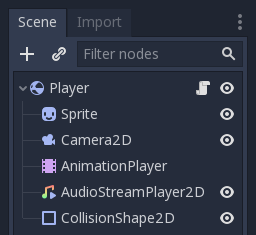
Now that the concept of nodes has been defined, the next logical step is to explain what a Scene is.
A scene is composed of a group of nodes organized hierarchically (in tree fashion). Furthermore, a scene:
- always has one root node.
- can be saved to disk and loaded back.
- can be instanced (more on that later).
Running a game means running a scene. A project can contain several scenes, but for the game to start, one of them must be selected as the main scene.
Basically, the Godot editor is a scene editor. It has plenty of tools for editing 2D and 3D scenes as well as user interfaces, but the editor is based on the concept of editing a scene and the nodes that compose it.
Editor¶
Open the project you made in Introduction to Godot’s editor, or create a new one. This will open the Godot editor:
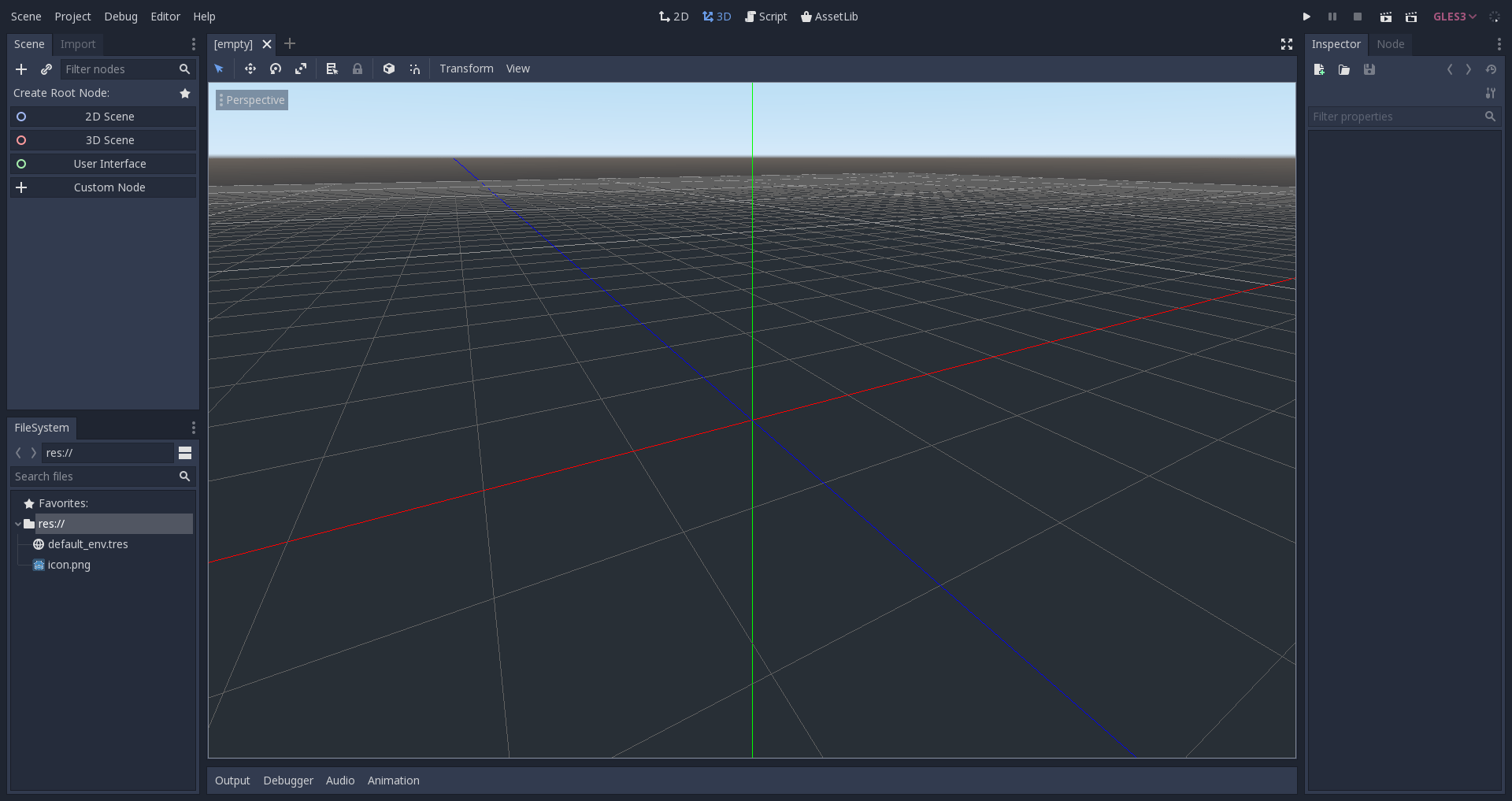
As mentioned before, making games in Godot feels like being in a kitchen, so let’s open the refrigerator and add some fresh nodes to the project. We’ll begin with a “Hello World” message that we’ll put on the screen.
To do this we need to add a Label node. Press the “Add Child Node” button at the top left of the scene dock (the icon represents a plus symbol). This button is the main way to add new nodes to a scene, and will always add the chosen node as a child of the currently selected node (or, in an empty scene, as the “root” node).
Note
In an empty scene (without root node), the scene dock shows several options to quickly add a root node to the scene. “2D Scene” adds a Node2D node, “3D Scene” adds a Spatial node, “User Interface” adds a Control node, and “Custom Node” which lets you select any node (so it is equivalent to pressing the “Add Child Node” button). You can also press the star-shaped icon to toggle the display of your favorited nodes.
Note that these presets are here for convenience and are not mandatory for the different types of scenes. Not every 3D scene needs a Spatial node as its root node, likewise not every GUI or 2D scene needs a Control node or Node2D as their root node.
Now, to add a label node to this scene you can click on the Custom Node button or the Add Node button at the top. In scenes that aren’t empty you use the add node button to create every child node.
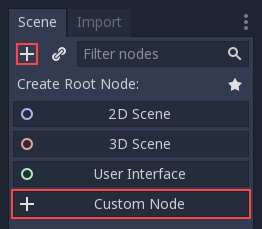
This will open the Create Node dialog, showing the long list of nodes that can be created:
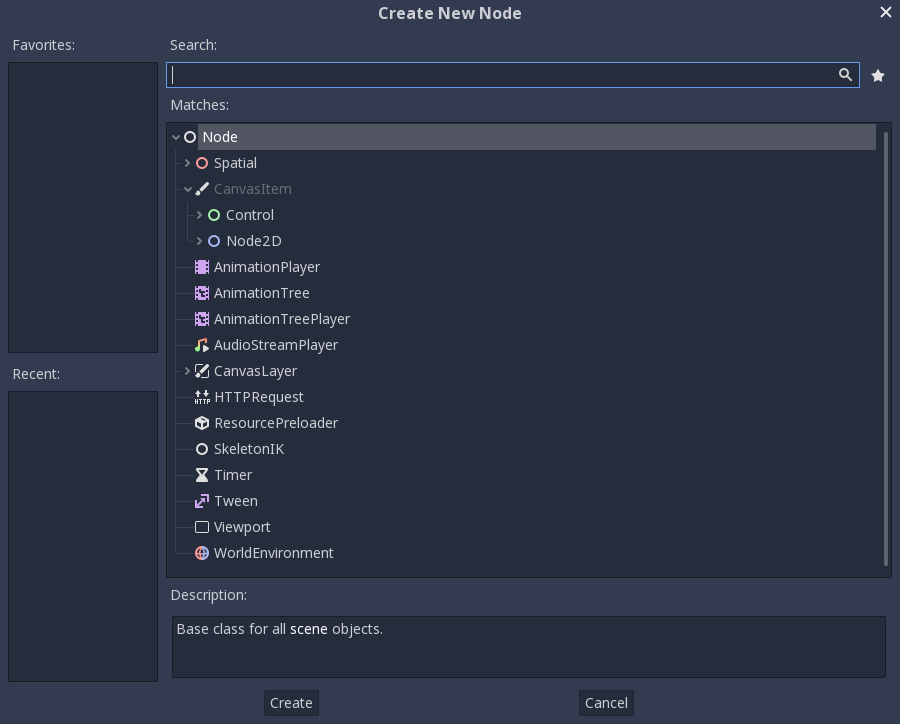
From there, select the “Label” node first. Searching for it is probably the fastest way:
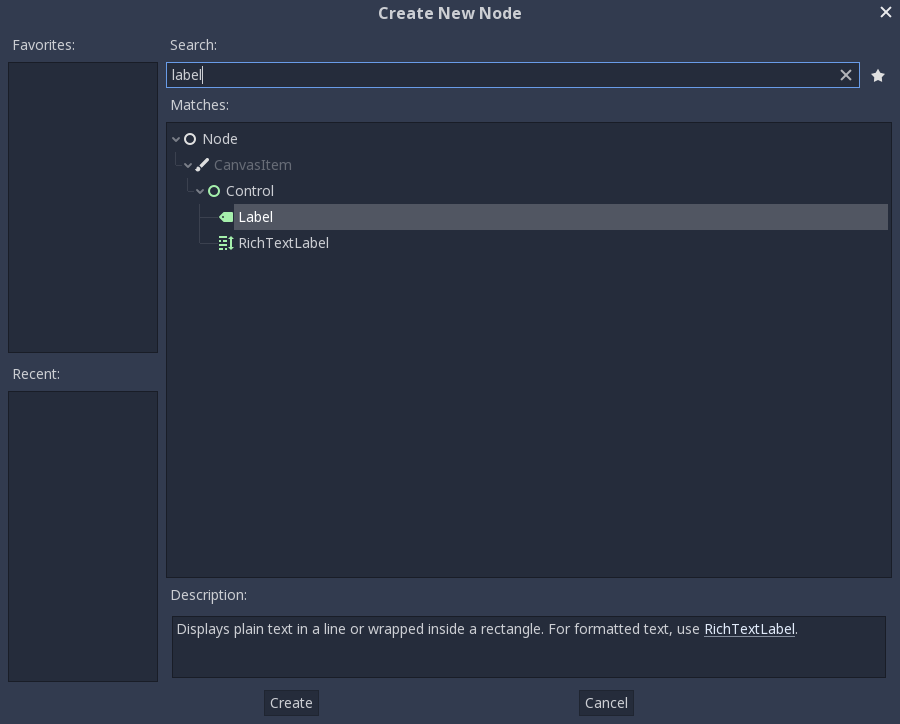
And finally, create the Label! A lot happens when Create is pressed:
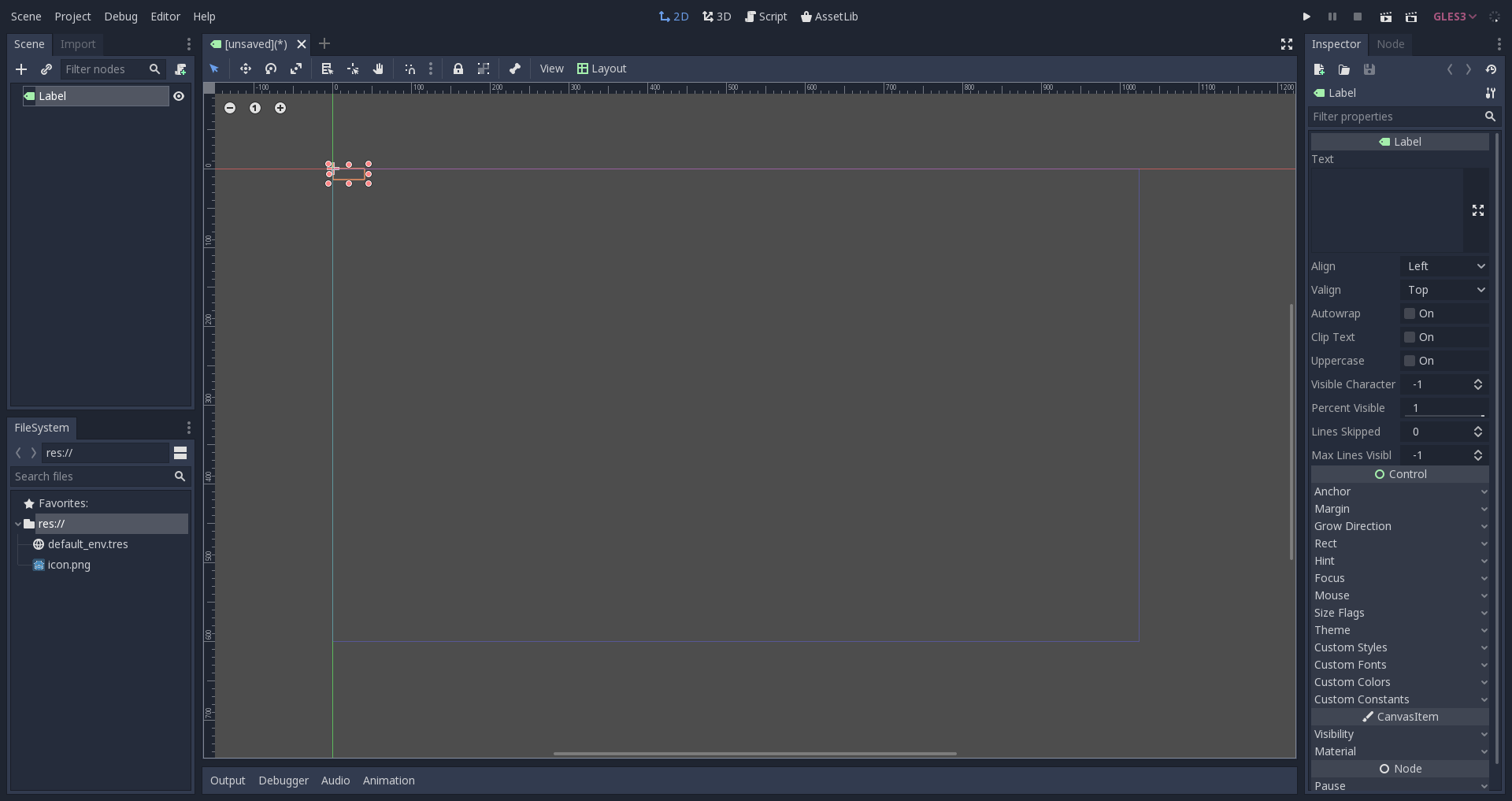
First of all, the scene changes to the 2D editor (because Label is a 2D Node type), and the Label appears, selected, at the top left corner of the viewport.
The node appears in the scene tree editor in the Scene dock, and the label properties appear in the Inspector dock.
The next step will be to change the “Text” Property of the label. Let’s change it to “Hello World”:
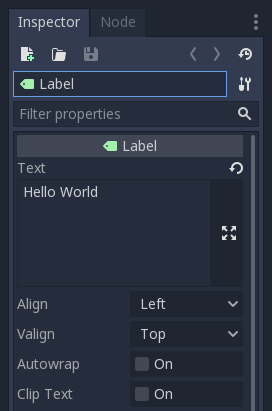
Ok, everything’s ready to run the scene! Press the PLAY SCENE Button on the top bar (or hit F6):

Aaaand… Oops.

Scenes need to be saved to be run, so save the scene to something like Hello.tscn in Scene -> Save:
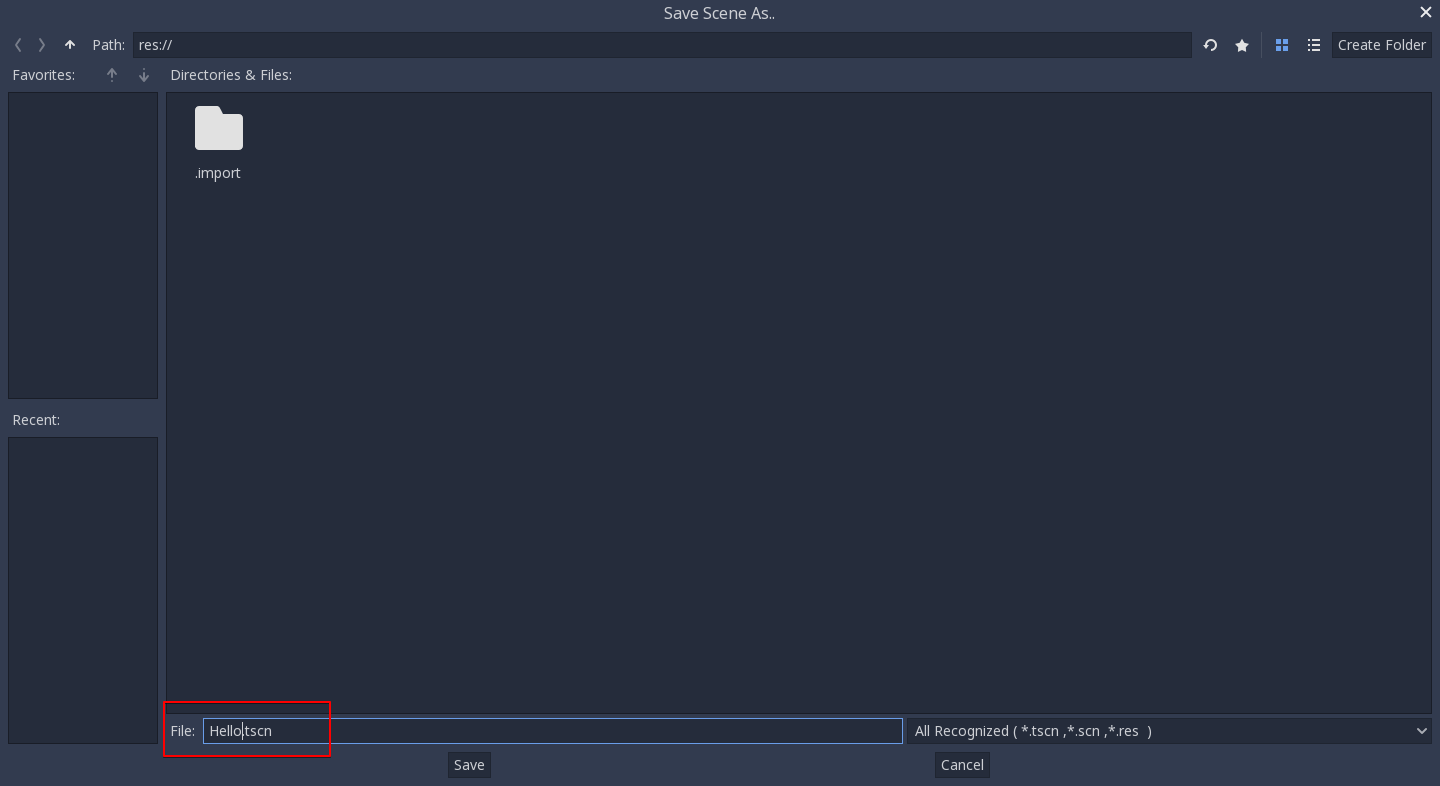
And here’s when something funny happens. The file dialog is a special
file dialog, and only allows you to save inside the project. The project
root is res:// which means “resource path”. This means that files can
only be saved inside the project. For the future, when doing file
operations in Godot, remember that res:// is the resource path, and no
matter the platform or install location, it is the way to locate where
resource files are from inside the game.
After saving the scene and pressing run scene again, the “Hello World” demo should finally execute:

Success!
Note
If this doesn’t immediately work and you have a hiDPI display on at least one of your monitors, go to Project → Project Settings → Display → Window then enable Allow Hidpi under Dpi.
Configuring the project¶
Ok, it’s time to configure the project. Right now, the only way to run something is to execute the current scene. Projects, however, may have several scenes, so one of them must be set as the main scene. This is the scene that will be loaded any time the project is run.
These settings are all stored in a project.godot file, which is a plaintext file in win.ini format (for easy editing). There are dozens of settings that you can change in this file to alter how a project executes. To simplify this process, Godot provides a project settings dialog, which acts as a sort of frontend to editing a project.godot file.
To access that dialog, select Project -> Project Settings. Try it now.
Once the window opens, let’s select a main scene. Locate the Application/Run/Main Scene property and click on it to select ‘Hello.tscn’.
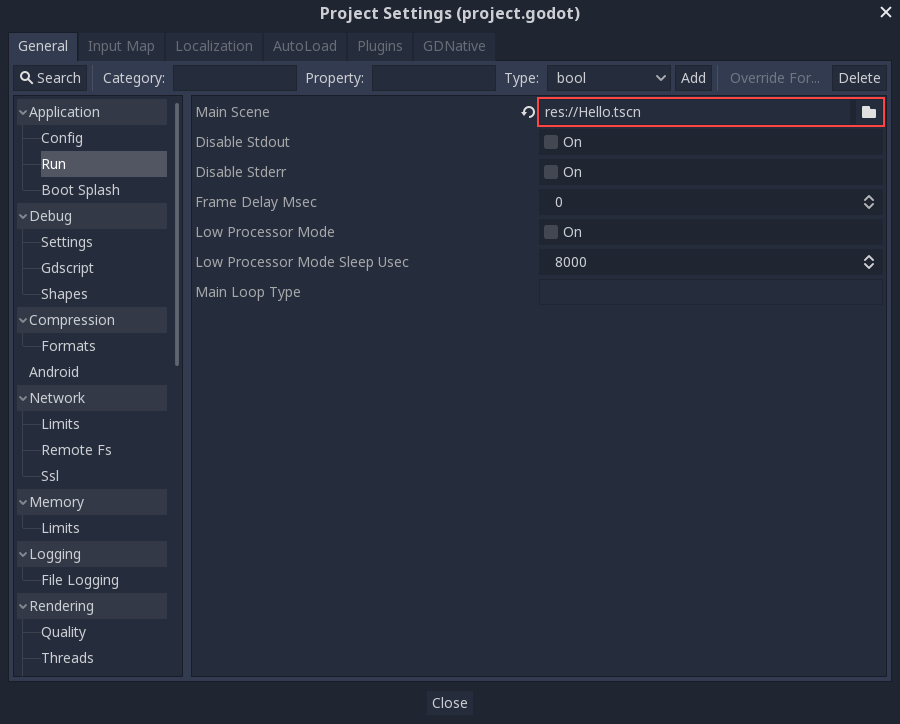
Now, with this change, when you press the regular Play button (or F5), this scene will run, no matter which scene is actively being edited.
The project settings dialog provides a lot of options that can be saved to a project.godot file and shows their default values. If you change a value, a tick is marked to the left of its name. This means that the property will be saved to the project.godot file and remembered.
As a side note, it is also possible to add custom configuration options and read them in at run-time using the ProjectSettings singleton.
To be continued…¶
This tutorial talked about “scenes and nodes”, but so far there has been only one scene and one node! Don’t worry, the next tutorial will expand on that…